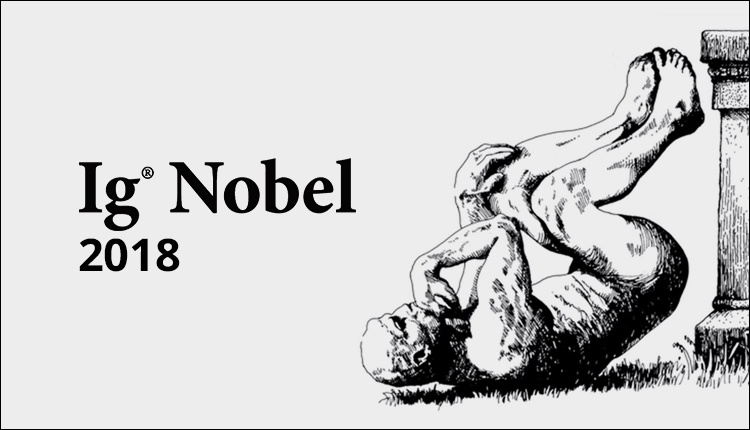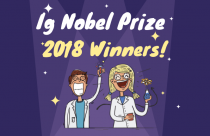Ig Nobel Prize Ceremony 2018: Celebrating Unconventional Thinking

We are all familiar with the Nobel Prize ceremony. Renowned scientists and personalities get global recognition for their groundbreaking discoveries and incredible innovations every year. However, there are some “not-so-ground-breaking” discoveries that most people are unaware of. Even these discoveries deserve mention as researchers have spent their precious time pursuing this research. Every year, the Ig Nobel Prize is a ceremony organized by the Improbable Blog. As suggested by the name, Improbable Research tries to bring “not-so-authentic” research into the limelight. When people come to know about this type of research, they tend to laugh at first. But then they start thinking about the same and get curious.
What is the Ig Nobel Prize?
The name Ig Nobel Prize is a pun on the term “ignoble” meaning “not noble or honorable.” It is the brainchild of Marc Abrahams, editor of the Annals of Improbable Research. These research ideas fulfill the major criteria of “not being authentic.” The ceremony “celebrates the unusual, honor the imaginative,” and thereby initiates interest in science, medicine, and technology. The winners collect their awards in Sander’s Theatre located at Harvard University in front of a crowd of 11,000 people. Interestingly, Nobel Laureates themselves hand over the Ig Nobel Prizes to researchers for their spectacular discoveries or inventions. Subsequently, these winners get invited to the Massachusetts Institute of Technology (MIT). In fact, they even deliver a speech on their award-winning research at this reputed institute.
Aim of the Ig Nobel Prize
The Ig Nobel Prize does not comment on whether the prize-winning research is authentic or hilarious. It simply highlights that people could even think in this way.
For example, we seldom wake up at the first ringing of the alarm clock. We tend to press the “Snooze” button and go off to sleep. This motivated Gauri Nanda, a scientist from MIT. She invented an alarm clock that rings and then runs away before hiding itself in a new place.
The Ig Nobel Prize also aims to mount curiosity into the minds of researchers and non-researchers alike. For example, you might have disliked the subject of Chemistry. Then you come across a topic that discusses the conversion of cow manure into vanilla flavoring. There is a fair chance you would raise an eyebrow and try to figure out what it is exactly about. The magazine Annals of Improbable Research receives about 5,000 nominations, out of which it shortlists only 10 winners every year.
What Do the Winners Say?
Generally, most of the Ig Nobel Laureates take this award very sportingly. They do not consider this demeaning in any way. However, there are a few scientists who think otherwise. In fact, in the year 1995, Robert May, the chief advisor to the British government, expressed his discontent towards the award ceremony. He drafted letters to the magazine and even to the journal Nature, putting forth the charges of ridiculing science. The editor of Improbable Research responded with the argument that the honorees are contacted beforehand and asked for their consent. He also added that this award ceremony highlights how science could be fun, even without maintaining the regular stereotypes. This ceremony succeeds in providing attention to researchers, who otherwise might not have come into the limelight.
Top 20 (Hilarious?) Ig Nobel Prizes
- ECONOMICS: Matthew Rockloff and Nancy Greer, for their experiments to see how contact with a live crocodile affects a person’s willingness to gamble.
- ARCTIC SCIENCE: Eigil Reimers and Sindre Eftestøl, for testing how reindeer react to seeing humans who are disguised as polar bears.
- MATHEMATICS: Nic Svenson and Piers Barnes of the Australian Commonwealth Scientific and Research Organization, for calculating the number of photographs you must take to (almost) ensure that nobody in a group photo will have their eyes closed.
- PHYSICS: John Mainstone and the late Thomas Parnell of the University of Queensland, Australia, for patiently conducting an experiment that began in the year 1927 — in which a glob of congealed black tar has been slowly, slowly dripping through a funnel, at a rate of approximately one drop every nine years.
- PEACE: Claire Rind and Peter Simmons of Newcastle University, in the U.K., for electrically monitoring the activity of a brain cell in a locust while that locust was watching selected highlights from the movie “Star Wars.”
- NUTRITION: Yoshiro Nakamats of Tokyo, Japan, for photographing and retrospectively analyzing every meal he has consumed during a period of 34 years (and counting).
- ECONOMICS: Gauri Nanda of the Massachusetts Institute of Technology, for inventing an alarm clock that runs away and hides, repeatedly, thus ensuring that people DO get out of bed, and thus theoretically adding many productive hours to the workday.
- CHEMISTRY: Edward Cussler of the University of Minnesota and Brian Gettelfinger of the University of Minnesota and the University of Wisconsin, for conducting a careful experiment to settle the longstanding scientific question: can people swim faster in syrup or in water?
- CHEMISTRY: Donatella Marazziti, Alessandra Rossi, and Giovanni B. Cassanoof the University of Pisa, and Hagop S. Akiskal of the University of California (San Diego). They discovered that, biochemically, romantic love may be indistinguishable from having the severe obsessive-compulsive disorder.
- BIOLOGY: Peter Fong of Gettysburg College, Gettysburg, Pennsylvania, for contributing to the happiness of clams by giving them Prozac.
- PHYSICS: Robert Matthews of Aston University, England, for his studies of Murphy’s Law. He even demonstrated that toast often falls on the buttered side.
- PSYCHOLOGY: Shigeru Watanabe, Junko Sakamoto, and Masumi Wakita, of Keio University, for their success in training pigeons to discriminate between the paintings of Picasso and those of Monet.
- NUTRITION: John Martinez of J. Martinez & Company in Atlanta, Georgia, for educating the world about Luak Coffee, the world’s most expensive coffee, which is made from coffee beans ingested and excreted by the luak (aka, the palm civet), a bobcat-like animal native to Indonesia.
- MATHEMATICS: The Southern Baptist Church of Alabama who are also the mathematical measurers of morality. They prepared a county-by-county estimate of how many Alabama citizens will go to hell if they don’t repent.
- ENTOMOLOGY: Robert A. Lopez of Westport, NY, valiant veterinarian, and friend of all creatures great and small. He conducted a series of experiments to obtain ear mites from cats, insert them into his own ear, and carefully observe and analyze the results.
- LITERATURE: Erich von Daniken, visionary raconteur and author of “Chariots of the Gods.” He explained how human civilization was influenced by ancient astronauts from outer space.
- PEACE: The Pepsi-Cola Company of the Phillipines, suppliers of sugary hopes and dreams. The company sponsored a contest to create a millionaire and then announced the wrong winning number. This incited and united 800,000 riotously expectant winners, and brought many warring factions together for the first time in their nation’s history.
- ASTRONOMY: Richard Hoagland of New Jersey, for identifying artificial features on the moon and on Mars. He even identified a human face on Mars and ten-mile high buildings on the far side of the moon.
- ECONOMICS. Richard Seed of Chicago for his efforts to stoke up the world economy by cloning himself and other human beings.
- PEACE: The British Royal Navy, for ordering its sailors to stop using live cannon shells, and to instead just shout “Bang!”
What do you think about this concept of Ig Nobel Prize? Please share your thoughts with us in the comments section below.
Stay tuned for our post on winners of Ig Nobel Prize 2018! Meanwhile, please click here to view the list of previous winners.





